Business Environment Analysis: Stakeholders, Factors and Global Impact
VerifiedAdded on 2019/12/03
|21
|5583
|413
Report
AI Summary
This report provides a comprehensive analysis of the business environment, focusing on understanding organizational purposes, stakeholder expectations, and the legal structures of various organizations like Burberry, McDonald's, NHS, and John Lewis Partnership. It delves into the nature of the national environment, examining economic systems, fiscal and monetary policies, and the impact of competition. The report further explores the behavior of organizations within their market environment, determining pricing strategies, assessing market forces, and evaluating the influence of business and cultural factors. Finally, it assesses the significance of global factors, including international trade and the impact of the European Union on UK businesses, providing a holistic view of the business landscape.
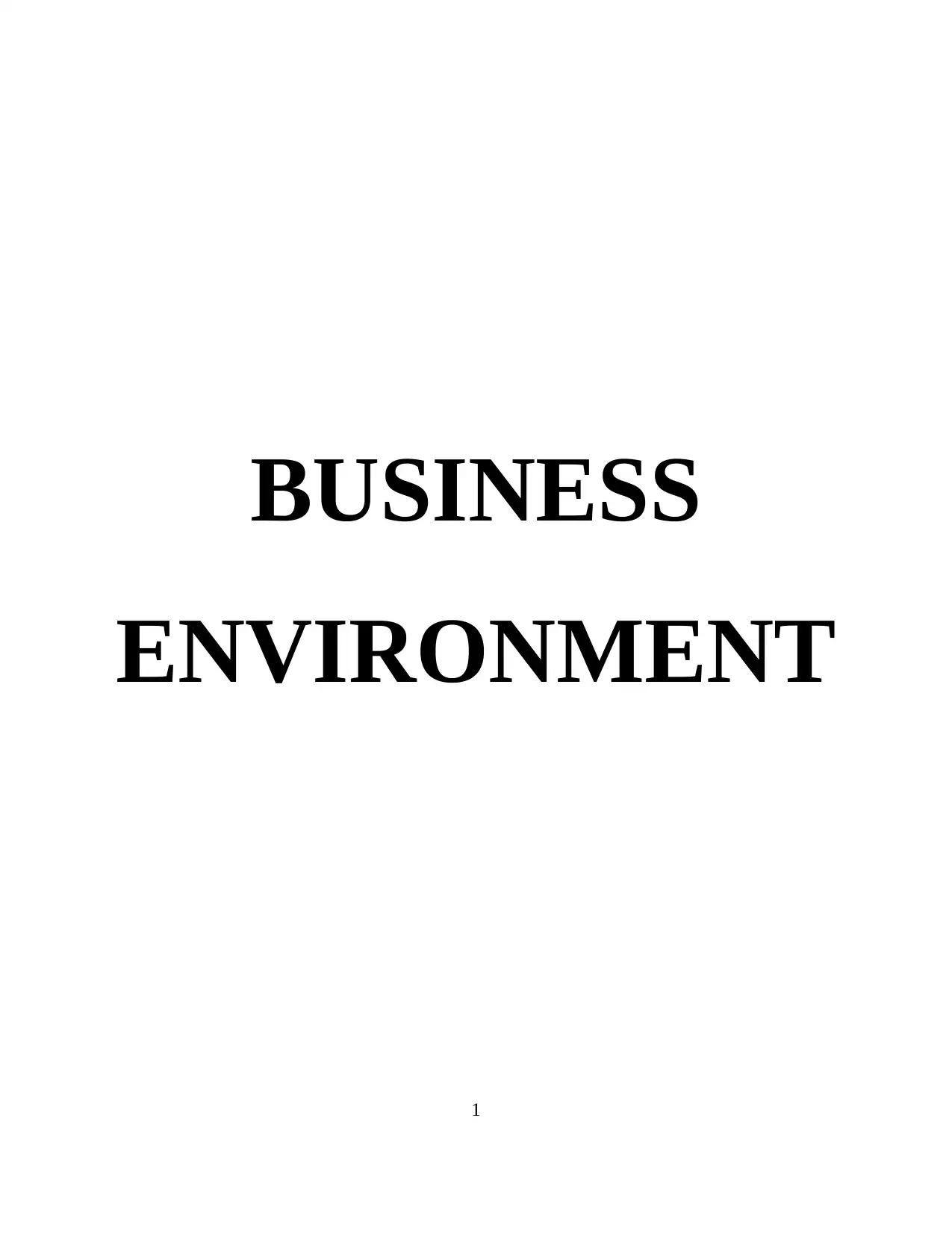
BUSINESS
ENVIRONMENT
1
ENVIRONMENT
1
Paraphrase This Document
Need a fresh take? Get an instant paraphrase of this document with our AI Paraphraser

TABLE OF CONTENTS
Introduction......................................................................................................................................4
LO1 : Understanding the Organizational purposes of businesses...................................................4
Q1. Identification of four types of organization and description of their legal structure............4
Q2. Stakeholders of the company................................................................................................5
Q3. Various responsibilities of an organization...........................................................................8
LO2 : Understand the nature of the national environment in which businesses operate.................9
Q4. Economic system of a country..............................................................................................9
Q5. Impact of fiscal and monetary policy..................................................................................10
Q6. Impact of competition policy..............................................................................................11
LO3 : Understand the behaviour of organizations in their market environment...........................12
Q7. Determination of pricing and output decision in different market structure.......................12
Q8. Market forces which shape short and long term organizational responses.........................14
Q9. Assessment of business and cultural environment shape the behavior of organization.....14
LO4 : Be able to assess the significance of the global factors that shape national businesses
activities.........................................................................................................................................15
Q10. Significance of international trade....................................................................................15
Q11. Impact of Global factor.....................................................................................................16
Q12. Evaluate the impact of European Union on UK business.................................................18
Conclusion.....................................................................................................................................19
References......................................................................................................................................20
2
Introduction......................................................................................................................................4
LO1 : Understanding the Organizational purposes of businesses...................................................4
Q1. Identification of four types of organization and description of their legal structure............4
Q2. Stakeholders of the company................................................................................................5
Q3. Various responsibilities of an organization...........................................................................8
LO2 : Understand the nature of the national environment in which businesses operate.................9
Q4. Economic system of a country..............................................................................................9
Q5. Impact of fiscal and monetary policy..................................................................................10
Q6. Impact of competition policy..............................................................................................11
LO3 : Understand the behaviour of organizations in their market environment...........................12
Q7. Determination of pricing and output decision in different market structure.......................12
Q8. Market forces which shape short and long term organizational responses.........................14
Q9. Assessment of business and cultural environment shape the behavior of organization.....14
LO4 : Be able to assess the significance of the global factors that shape national businesses
activities.........................................................................................................................................15
Q10. Significance of international trade....................................................................................15
Q11. Impact of Global factor.....................................................................................................16
Q12. Evaluate the impact of European Union on UK business.................................................18
Conclusion.....................................................................................................................................19
References......................................................................................................................................20
2

INDEX OF TABLES
Table 1: Legal Structure...................................................................................................................4
Table 2: Organizational Purposes....................................................................................................4
Table 3: McDonald's Stakeholders and their Objectives.................................................................6
Table 4: Burberry's Stakeholders and their Objectives....................................................................7
Table 5: Allocation of Resources.....................................................................................................9
Table 6: Fiscal and Monetary Policy.............................................................................................10
Table 7: Impact of Competition Policy..........................................................................................11
Table 8: Different Market Structure..............................................................................................13
Table 9: Advantage and Disadvantages.........................................................................................15
Table 10: Impact of Global Factor.................................................................................................16
Table 11: Impact of European Union.............................................................................................18
ILLUSTRATION INDEX
Illustration 1: Types of Responsibilities..........................................................................................8
Illustration 2: Market Structure......................................................................................................13
3
Table 1: Legal Structure...................................................................................................................4
Table 2: Organizational Purposes....................................................................................................4
Table 3: McDonald's Stakeholders and their Objectives.................................................................6
Table 4: Burberry's Stakeholders and their Objectives....................................................................7
Table 5: Allocation of Resources.....................................................................................................9
Table 6: Fiscal and Monetary Policy.............................................................................................10
Table 7: Impact of Competition Policy..........................................................................................11
Table 8: Different Market Structure..............................................................................................13
Table 9: Advantage and Disadvantages.........................................................................................15
Table 10: Impact of Global Factor.................................................................................................16
Table 11: Impact of European Union.............................................................................................18
ILLUSTRATION INDEX
Illustration 1: Types of Responsibilities..........................................................................................8
Illustration 2: Market Structure......................................................................................................13
3
⊘ This is a preview!⊘
Do you want full access?
Subscribe today to unlock all pages.

Trusted by 1+ million students worldwide
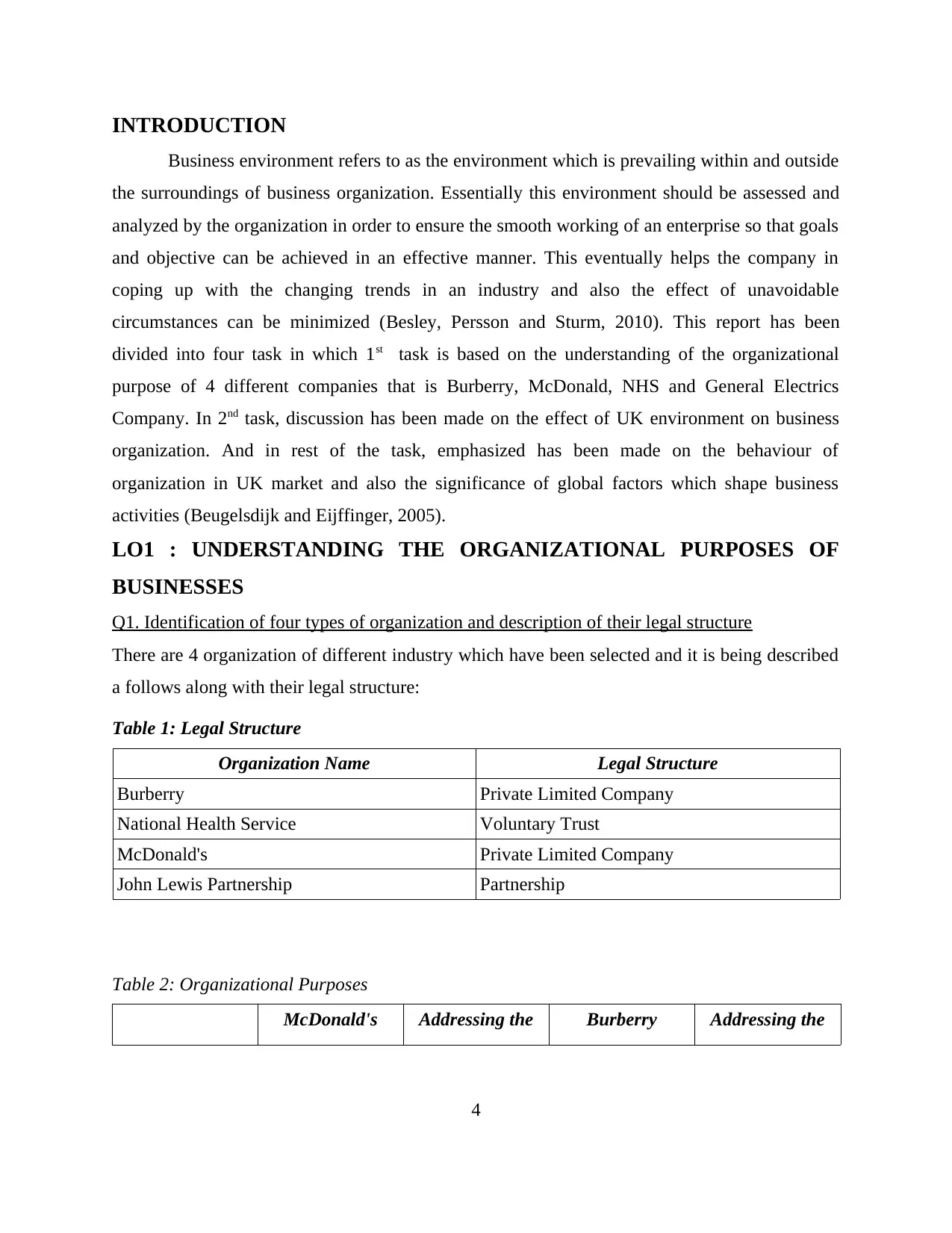
INTRODUCTION
Business environment refers to as the environment which is prevailing within and outside
the surroundings of business organization. Essentially this environment should be assessed and
analyzed by the organization in order to ensure the smooth working of an enterprise so that goals
and objective can be achieved in an effective manner. This eventually helps the company in
coping up with the changing trends in an industry and also the effect of unavoidable
circumstances can be minimized (Besley, Persson and Sturm, 2010). This report has been
divided into four task in which 1st task is based on the understanding of the organizational
purpose of 4 different companies that is Burberry, McDonald, NHS and General Electrics
Company. In 2nd task, discussion has been made on the effect of UK environment on business
organization. And in rest of the task, emphasized has been made on the behaviour of
organization in UK market and also the significance of global factors which shape business
activities (Beugelsdijk and Eijffinger, 2005).
LO1 : UNDERSTANDING THE ORGANIZATIONAL PURPOSES OF
BUSINESSES
Q1. Identification of four types of organization and description of their legal structure
There are 4 organization of different industry which have been selected and it is being described
a follows along with their legal structure:
Table 1: Legal Structure
Organization Name Legal Structure
Burberry Private Limited Company
National Health Service Voluntary Trust
McDonald's Private Limited Company
John Lewis Partnership Partnership
Table 2: Organizational Purposes
McDonald's Addressing the Burberry Addressing the
4
Business environment refers to as the environment which is prevailing within and outside
the surroundings of business organization. Essentially this environment should be assessed and
analyzed by the organization in order to ensure the smooth working of an enterprise so that goals
and objective can be achieved in an effective manner. This eventually helps the company in
coping up with the changing trends in an industry and also the effect of unavoidable
circumstances can be minimized (Besley, Persson and Sturm, 2010). This report has been
divided into four task in which 1st task is based on the understanding of the organizational
purpose of 4 different companies that is Burberry, McDonald, NHS and General Electrics
Company. In 2nd task, discussion has been made on the effect of UK environment on business
organization. And in rest of the task, emphasized has been made on the behaviour of
organization in UK market and also the significance of global factors which shape business
activities (Beugelsdijk and Eijffinger, 2005).
LO1 : UNDERSTANDING THE ORGANIZATIONAL PURPOSES OF
BUSINESSES
Q1. Identification of four types of organization and description of their legal structure
There are 4 organization of different industry which have been selected and it is being described
a follows along with their legal structure:
Table 1: Legal Structure
Organization Name Legal Structure
Burberry Private Limited Company
National Health Service Voluntary Trust
McDonald's Private Limited Company
John Lewis Partnership Partnership
Table 2: Organizational Purposes
McDonald's Addressing the Burberry Addressing the
4
Paraphrase This Document
Need a fresh take? Get an instant paraphrase of this document with our AI Paraphraser
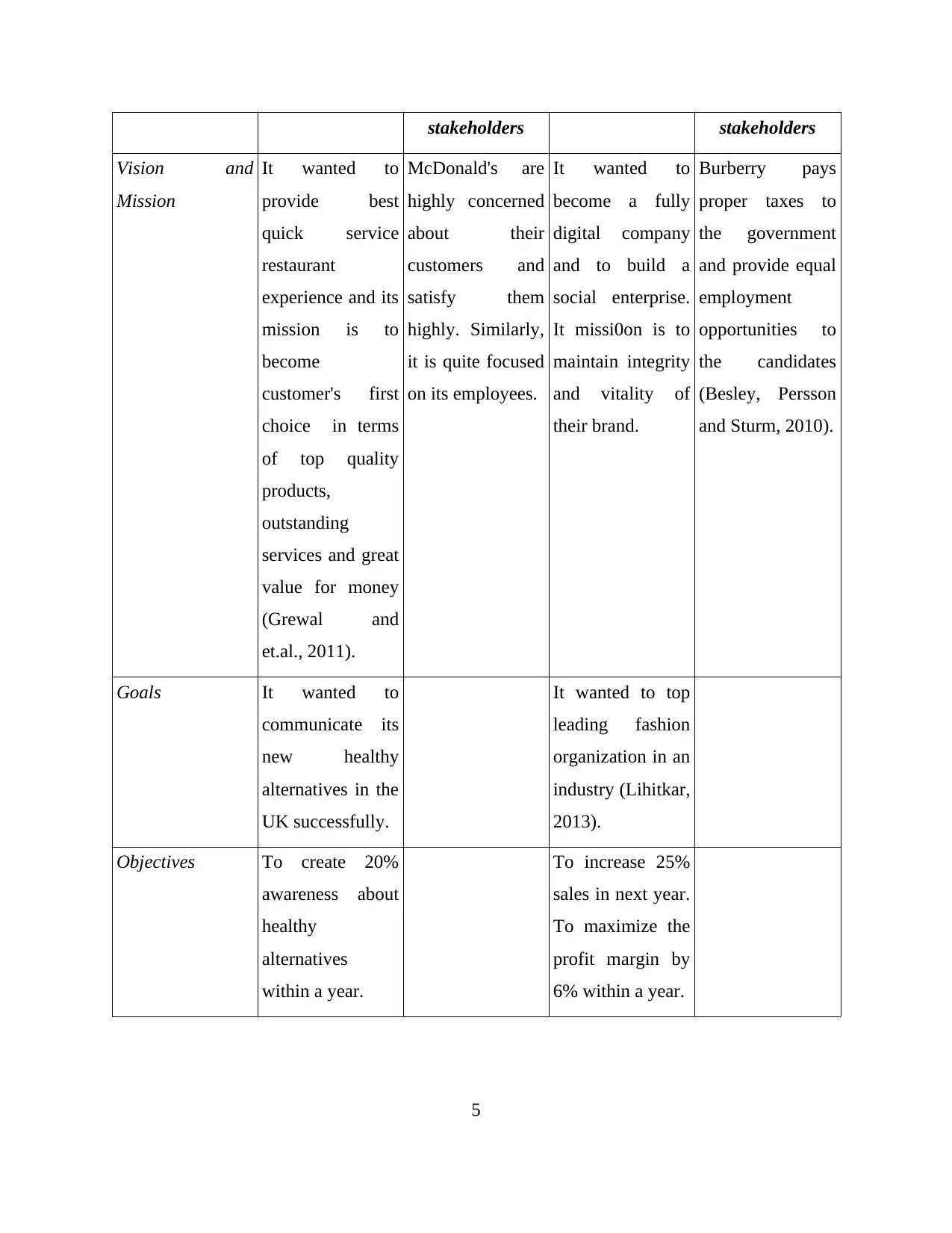
stakeholders stakeholders
Vision and
Mission
It wanted to
provide best
quick service
restaurant
experience and its
mission is to
become
customer's first
choice in terms
of top quality
products,
outstanding
services and great
value for money
(Grewal and
et.al., 2011).
McDonald's are
highly concerned
about their
customers and
satisfy them
highly. Similarly,
it is quite focused
on its employees.
It wanted to
become a fully
digital company
and to build a
social enterprise.
It missi0on is to
maintain integrity
and vitality of
their brand.
Burberry pays
proper taxes to
the government
and provide equal
employment
opportunities to
the candidates
(Besley, Persson
and Sturm, 2010).
Goals It wanted to
communicate its
new healthy
alternatives in the
UK successfully.
It wanted to top
leading fashion
organization in an
industry (Lihitkar,
2013).
Objectives To create 20%
awareness about
healthy
alternatives
within a year.
To increase 25%
sales in next year.
To maximize the
profit margin by
6% within a year.
5
Vision and
Mission
It wanted to
provide best
quick service
restaurant
experience and its
mission is to
become
customer's first
choice in terms
of top quality
products,
outstanding
services and great
value for money
(Grewal and
et.al., 2011).
McDonald's are
highly concerned
about their
customers and
satisfy them
highly. Similarly,
it is quite focused
on its employees.
It wanted to
become a fully
digital company
and to build a
social enterprise.
It missi0on is to
maintain integrity
and vitality of
their brand.
Burberry pays
proper taxes to
the government
and provide equal
employment
opportunities to
the candidates
(Besley, Persson
and Sturm, 2010).
Goals It wanted to
communicate its
new healthy
alternatives in the
UK successfully.
It wanted to top
leading fashion
organization in an
industry (Lihitkar,
2013).
Objectives To create 20%
awareness about
healthy
alternatives
within a year.
To increase 25%
sales in next year.
To maximize the
profit margin by
6% within a year.
5
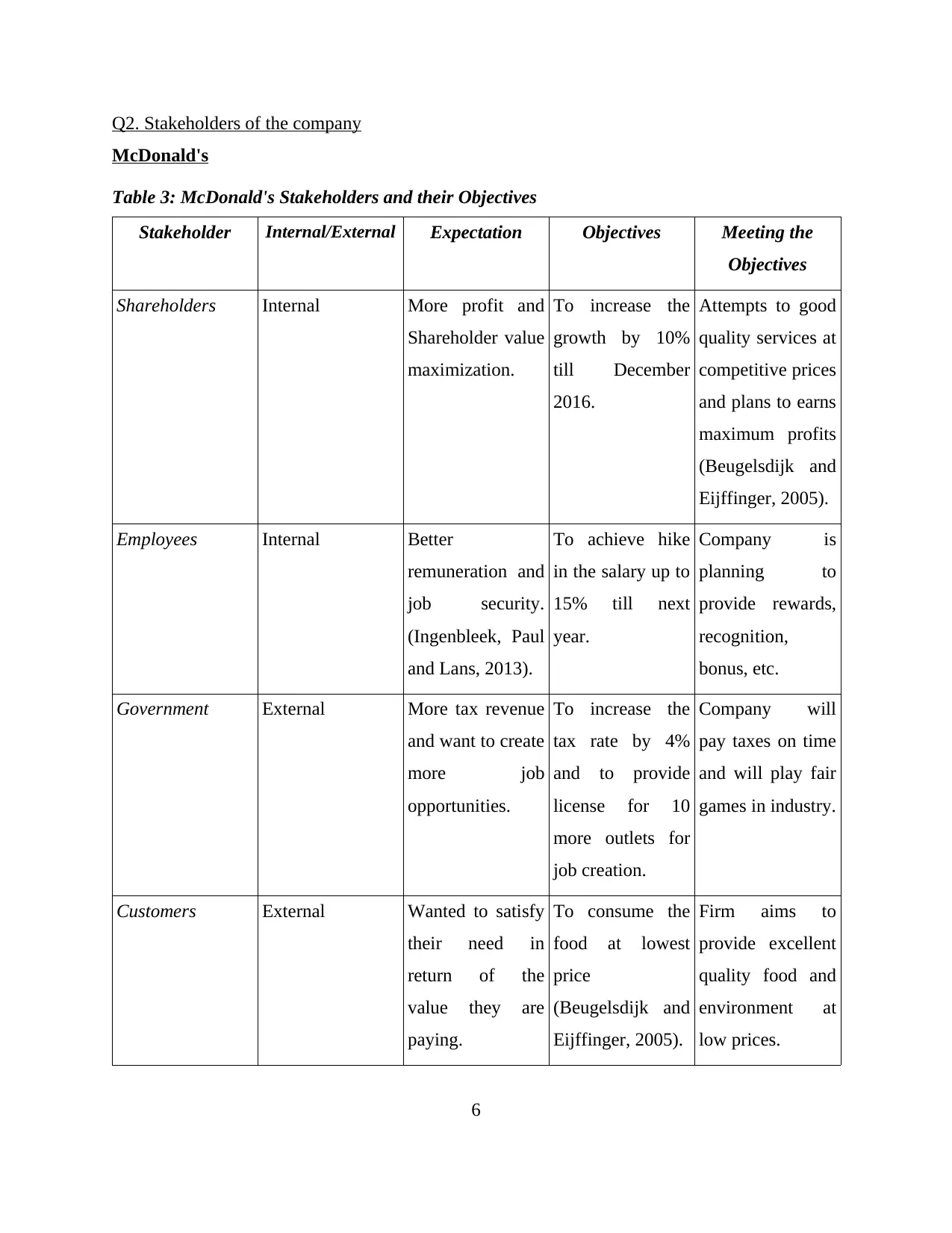
Q2. Stakeholders of the company
McDonald's
Table 3: McDonald's Stakeholders and their Objectives
Stakeholder Internal/External Expectation Objectives Meeting the
Objectives
Shareholders Internal More profit and
Shareholder value
maximization.
To increase the
growth by 10%
till December
2016.
Attempts to good
quality services at
competitive prices
and plans to earns
maximum profits
(Beugelsdijk and
Eijffinger, 2005).
Employees Internal Better
remuneration and
job security.
(Ingenbleek, Paul
and Lans, 2013).
To achieve hike
in the salary up to
15% till next
year.
Company is
planning to
provide rewards,
recognition,
bonus, etc.
Government External More tax revenue
and want to create
more job
opportunities.
To increase the
tax rate by 4%
and to provide
license for 10
more outlets for
job creation.
Company will
pay taxes on time
and will play fair
games in industry.
Customers External Wanted to satisfy
their need in
return of the
value they are
paying.
To consume the
food at lowest
price
(Beugelsdijk and
Eijffinger, 2005).
Firm aims to
provide excellent
quality food and
environment at
low prices.
6
McDonald's
Table 3: McDonald's Stakeholders and their Objectives
Stakeholder Internal/External Expectation Objectives Meeting the
Objectives
Shareholders Internal More profit and
Shareholder value
maximization.
To increase the
growth by 10%
till December
2016.
Attempts to good
quality services at
competitive prices
and plans to earns
maximum profits
(Beugelsdijk and
Eijffinger, 2005).
Employees Internal Better
remuneration and
job security.
(Ingenbleek, Paul
and Lans, 2013).
To achieve hike
in the salary up to
15% till next
year.
Company is
planning to
provide rewards,
recognition,
bonus, etc.
Government External More tax revenue
and want to create
more job
opportunities.
To increase the
tax rate by 4%
and to provide
license for 10
more outlets for
job creation.
Company will
pay taxes on time
and will play fair
games in industry.
Customers External Wanted to satisfy
their need in
return of the
value they are
paying.
To consume the
food at lowest
price
(Beugelsdijk and
Eijffinger, 2005).
Firm aims to
provide excellent
quality food and
environment at
low prices.
6
⊘ This is a preview!⊘
Do you want full access?
Subscribe today to unlock all pages.

Trusted by 1+ million students worldwide

Moreover,
hygienic and
nutritious food.
Burberry
Table 4: Burberry's Stakeholders and their Objectives
Stakeholder Internal/External Expectations Objectives Meeting the
Objectives
Shareholders Internal High return on
investment and
want the share
price to remain
high
To increase the
growth by 20%.
Company will
provide good
earning per share
by increasing the
goodwill of the
brand.
Employees Internal High job
satisfaction and
job security
(Lihitkar, 2013).
To extend the
employment
contract by 2
more years.
As per the
employment law
company will
plan to extend the
contract.
Government External Want more tax
revenue and fair
trading in the
industry.
To increase the
tax rate by 4%. to
employ more
trade barriers to
prevent unfair
practices
Company aims to
play fair games
and pays the taxes
in an appropriate
manner. (Snyman,
Kourie And
Botha, 2014).
Customers External They want
innovative
To increase the
demand up to 5%.
Company is
planning for
7
hygienic and
nutritious food.
Burberry
Table 4: Burberry's Stakeholders and their Objectives
Stakeholder Internal/External Expectations Objectives Meeting the
Objectives
Shareholders Internal High return on
investment and
want the share
price to remain
high
To increase the
growth by 20%.
Company will
provide good
earning per share
by increasing the
goodwill of the
brand.
Employees Internal High job
satisfaction and
job security
(Lihitkar, 2013).
To extend the
employment
contract by 2
more years.
As per the
employment law
company will
plan to extend the
contract.
Government External Want more tax
revenue and fair
trading in the
industry.
To increase the
tax rate by 4%. to
employ more
trade barriers to
prevent unfair
practices
Company aims to
play fair games
and pays the taxes
in an appropriate
manner. (Snyman,
Kourie And
Botha, 2014).
Customers External They want
innovative
To increase the
demand up to 5%.
Company is
planning for
7
Paraphrase This Document
Need a fresh take? Get an instant paraphrase of this document with our AI Paraphraser

products as per
the changing
lifestyle and
cultural diversity
(Beugelsdijk and
Eijffinger, 2005).
to pay lesser
amount for
quality products.
expansion to
make it
convenient for the
customers.
Further, planning
to bring changes
as per the
requirements.
Q3. Various responsibilities of an organization
McDonald's and Burberry are highly responsible in performing its duty towards various
factors. Company has been formed for various purposes so that responsibilities towards all the
elements can be fulfilled. Purposes of organization are as follows:
1. Purposes: McDonald's and Burberry wants to enhance their profits by expanding their
businesses. Services towards the customers should be efficient so as to satisfy them and
earn maximum profits (Parkin, 2012). Further, both the firms aims towards the
fulfillment of corporate social responsibilities so that society does not get any harm due
to the business performance. Similarly, company wanted to work ethically and provide
equal opportunities to their employees.
2. Responsibilities: According to Carroll's Pyramid the responsibilities of an organization
can be understood and also its fulfillment towards various elements.
8
the changing
lifestyle and
cultural diversity
(Beugelsdijk and
Eijffinger, 2005).
to pay lesser
amount for
quality products.
expansion to
make it
convenient for the
customers.
Further, planning
to bring changes
as per the
requirements.
Q3. Various responsibilities of an organization
McDonald's and Burberry are highly responsible in performing its duty towards various
factors. Company has been formed for various purposes so that responsibilities towards all the
elements can be fulfilled. Purposes of organization are as follows:
1. Purposes: McDonald's and Burberry wants to enhance their profits by expanding their
businesses. Services towards the customers should be efficient so as to satisfy them and
earn maximum profits (Parkin, 2012). Further, both the firms aims towards the
fulfillment of corporate social responsibilities so that society does not get any harm due
to the business performance. Similarly, company wanted to work ethically and provide
equal opportunities to their employees.
2. Responsibilities: According to Carroll's Pyramid the responsibilities of an organization
can be understood and also its fulfillment towards various elements.
8
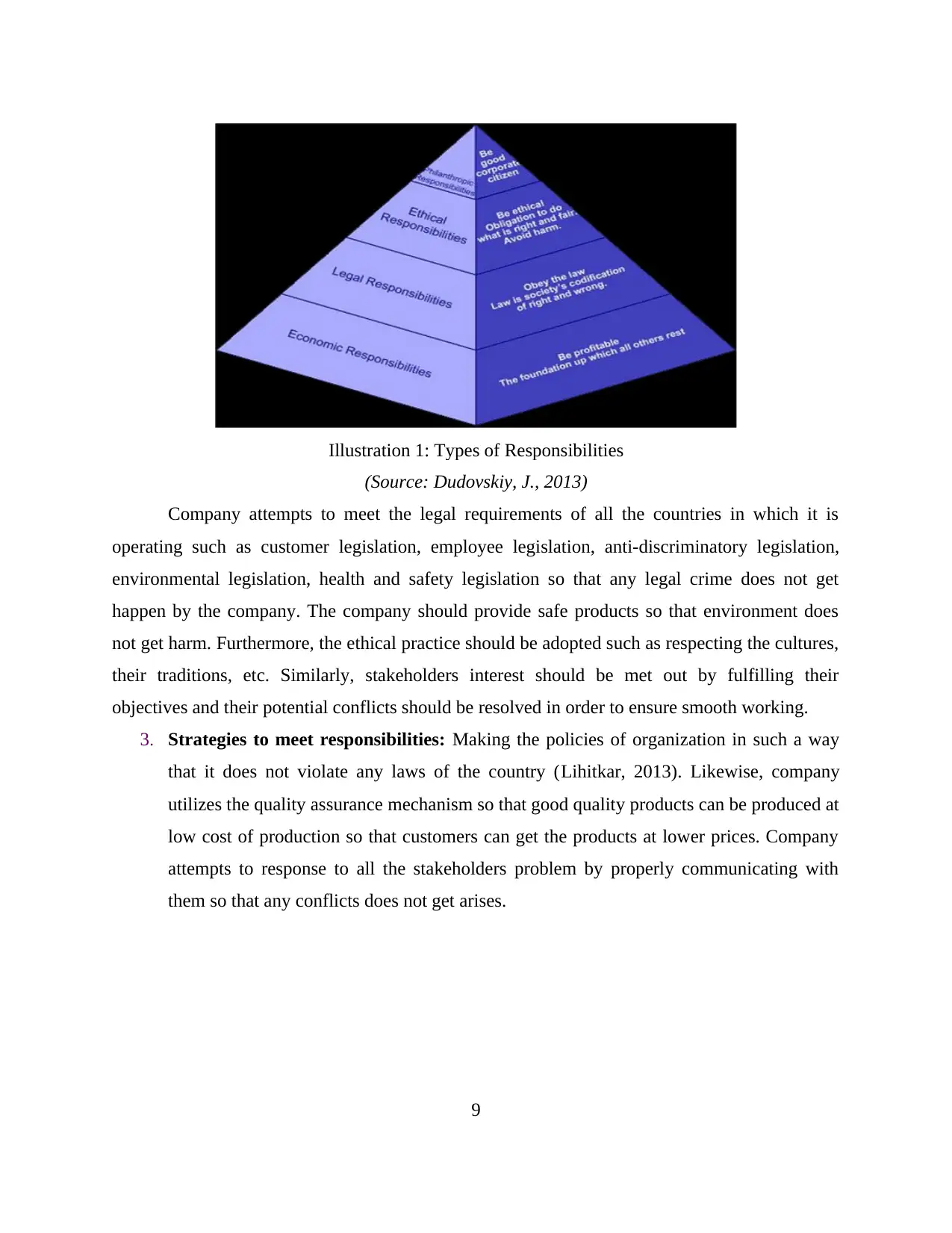
(Source: Dudovskiy, J., 2013)
Company attempts to meet the legal requirements of all the countries in which it is
operating such as customer legislation, employee legislation, anti-discriminatory legislation,
environmental legislation, health and safety legislation so that any legal crime does not get
happen by the company. The company should provide safe products so that environment does
not get harm. Furthermore, the ethical practice should be adopted such as respecting the cultures,
their traditions, etc. Similarly, stakeholders interest should be met out by fulfilling their
objectives and their potential conflicts should be resolved in order to ensure smooth working.
3. Strategies to meet responsibilities: Making the policies of organization in such a way
that it does not violate any laws of the country (Lihitkar, 2013). Likewise, company
utilizes the quality assurance mechanism so that good quality products can be produced at
low cost of production so that customers can get the products at lower prices. Company
attempts to response to all the stakeholders problem by properly communicating with
them so that any conflicts does not get arises.
9
Illustration 1: Types of Responsibilities
Company attempts to meet the legal requirements of all the countries in which it is
operating such as customer legislation, employee legislation, anti-discriminatory legislation,
environmental legislation, health and safety legislation so that any legal crime does not get
happen by the company. The company should provide safe products so that environment does
not get harm. Furthermore, the ethical practice should be adopted such as respecting the cultures,
their traditions, etc. Similarly, stakeholders interest should be met out by fulfilling their
objectives and their potential conflicts should be resolved in order to ensure smooth working.
3. Strategies to meet responsibilities: Making the policies of organization in such a way
that it does not violate any laws of the country (Lihitkar, 2013). Likewise, company
utilizes the quality assurance mechanism so that good quality products can be produced at
low cost of production so that customers can get the products at lower prices. Company
attempts to response to all the stakeholders problem by properly communicating with
them so that any conflicts does not get arises.
9
Illustration 1: Types of Responsibilities
⊘ This is a preview!⊘
Do you want full access?
Subscribe today to unlock all pages.

Trusted by 1+ million students worldwide
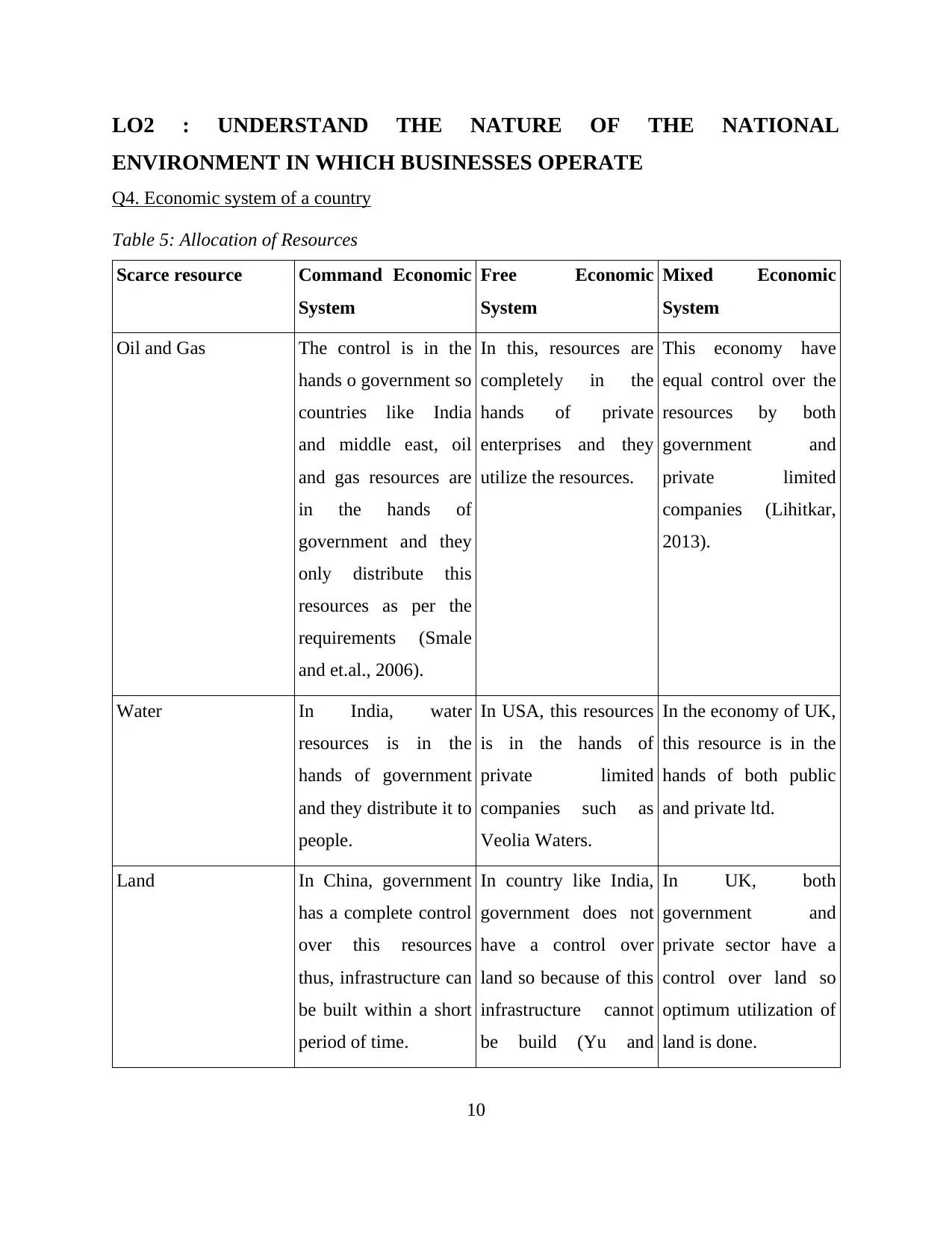
LO2 : UNDERSTAND THE NATURE OF THE NATIONAL
ENVIRONMENT IN WHICH BUSINESSES OPERATE
Q4. Economic system of a country
Table 5: Allocation of Resources
Scarce resource Command Economic
System
Free Economic
System
Mixed Economic
System
Oil and Gas The control is in the
hands o government so
countries like India
and middle east, oil
and gas resources are
in the hands of
government and they
only distribute this
resources as per the
requirements (Smale
and et.al., 2006).
In this, resources are
completely in the
hands of private
enterprises and they
utilize the resources.
This economy have
equal control over the
resources by both
government and
private limited
companies (Lihitkar,
2013).
Water In India, water
resources is in the
hands of government
and they distribute it to
people.
In USA, this resources
is in the hands of
private limited
companies such as
Veolia Waters.
In the economy of UK,
this resource is in the
hands of both public
and private ltd.
Land In China, government
has a complete control
over this resources
thus, infrastructure can
be built within a short
period of time.
In country like India,
government does not
have a control over
land so because of this
infrastructure cannot
be build (Yu and
In UK, both
government and
private sector have a
control over land so
optimum utilization of
land is done.
10
ENVIRONMENT IN WHICH BUSINESSES OPERATE
Q4. Economic system of a country
Table 5: Allocation of Resources
Scarce resource Command Economic
System
Free Economic
System
Mixed Economic
System
Oil and Gas The control is in the
hands o government so
countries like India
and middle east, oil
and gas resources are
in the hands of
government and they
only distribute this
resources as per the
requirements (Smale
and et.al., 2006).
In this, resources are
completely in the
hands of private
enterprises and they
utilize the resources.
This economy have
equal control over the
resources by both
government and
private limited
companies (Lihitkar,
2013).
Water In India, water
resources is in the
hands of government
and they distribute it to
people.
In USA, this resources
is in the hands of
private limited
companies such as
Veolia Waters.
In the economy of UK,
this resource is in the
hands of both public
and private ltd.
Land In China, government
has a complete control
over this resources
thus, infrastructure can
be built within a short
period of time.
In country like India,
government does not
have a control over
land so because of this
infrastructure cannot
be build (Yu and
In UK, both
government and
private sector have a
control over land so
optimum utilization of
land is done.
10
Paraphrase This Document
Need a fresh take? Get an instant paraphrase of this document with our AI Paraphraser
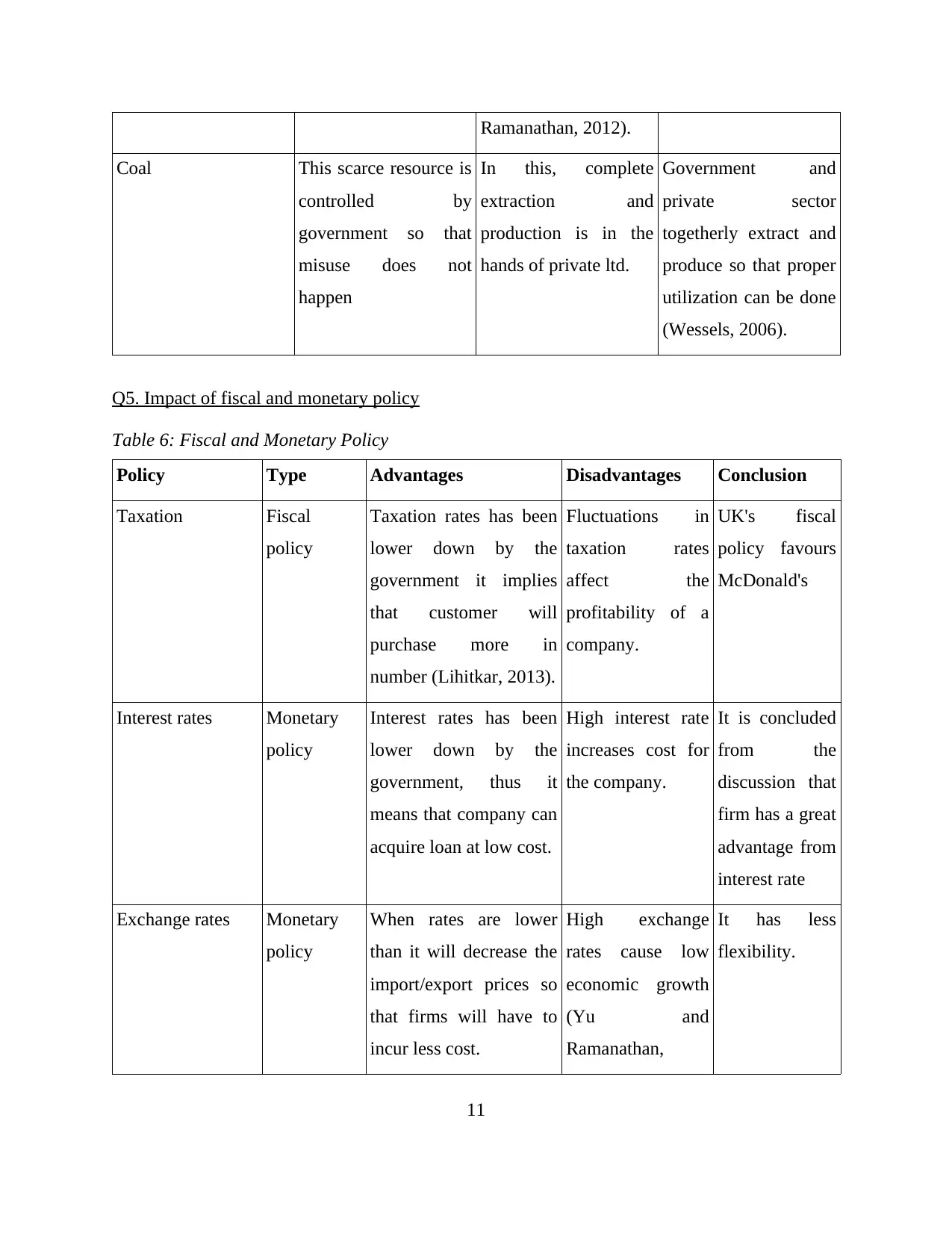
Ramanathan, 2012).
Coal This scarce resource is
controlled by
government so that
misuse does not
happen
In this, complete
extraction and
production is in the
hands of private ltd.
Government and
private sector
togetherly extract and
produce so that proper
utilization can be done
(Wessels, 2006).
Q5. Impact of fiscal and monetary policy
Table 6: Fiscal and Monetary Policy
Policy Type Advantages Disadvantages Conclusion
Taxation Fiscal
policy
Taxation rates has been
lower down by the
government it implies
that customer will
purchase more in
number (Lihitkar, 2013).
Fluctuations in
taxation rates
affect the
profitability of a
company.
UK's fiscal
policy favours
McDonald's
Interest rates Monetary
policy
Interest rates has been
lower down by the
government, thus it
means that company can
acquire loan at low cost.
High interest rate
increases cost for
the company.
It is concluded
from the
discussion that
firm has a great
advantage from
interest rate
Exchange rates Monetary
policy
When rates are lower
than it will decrease the
import/export prices so
that firms will have to
incur less cost.
High exchange
rates cause low
economic growth
(Yu and
Ramanathan,
It has less
flexibility.
11
Coal This scarce resource is
controlled by
government so that
misuse does not
happen
In this, complete
extraction and
production is in the
hands of private ltd.
Government and
private sector
togetherly extract and
produce so that proper
utilization can be done
(Wessels, 2006).
Q5. Impact of fiscal and monetary policy
Table 6: Fiscal and Monetary Policy
Policy Type Advantages Disadvantages Conclusion
Taxation Fiscal
policy
Taxation rates has been
lower down by the
government it implies
that customer will
purchase more in
number (Lihitkar, 2013).
Fluctuations in
taxation rates
affect the
profitability of a
company.
UK's fiscal
policy favours
McDonald's
Interest rates Monetary
policy
Interest rates has been
lower down by the
government, thus it
means that company can
acquire loan at low cost.
High interest rate
increases cost for
the company.
It is concluded
from the
discussion that
firm has a great
advantage from
interest rate
Exchange rates Monetary
policy
When rates are lower
than it will decrease the
import/export prices so
that firms will have to
incur less cost.
High exchange
rates cause low
economic growth
(Yu and
Ramanathan,
It has less
flexibility.
11
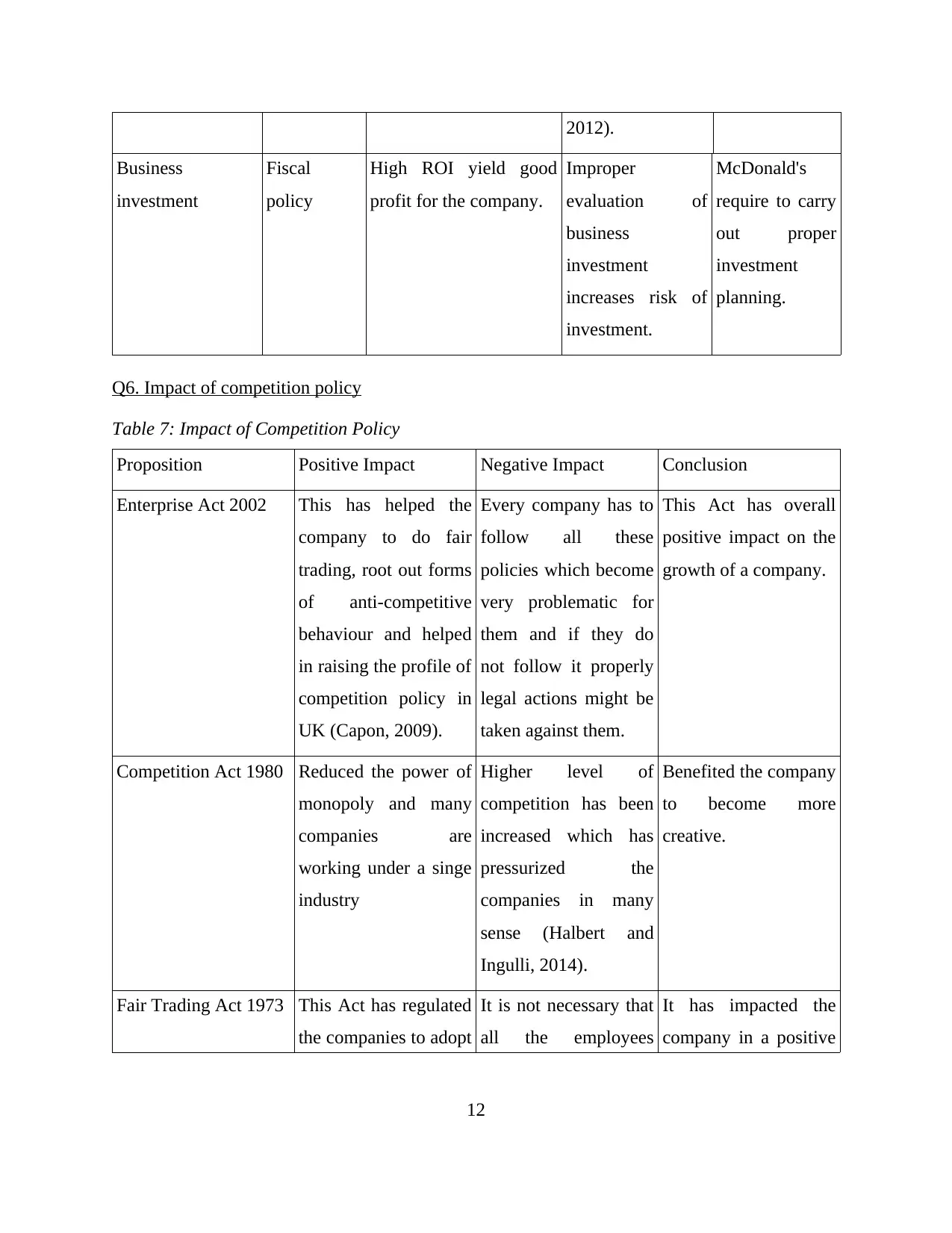
2012).
Business
investment
Fiscal
policy
High ROI yield good
profit for the company.
Improper
evaluation of
business
investment
increases risk of
investment.
McDonald's
require to carry
out proper
investment
planning.
Q6. Impact of competition policy
Table 7: Impact of Competition Policy
Proposition Positive Impact Negative Impact Conclusion
Enterprise Act 2002 This has helped the
company to do fair
trading, root out forms
of anti-competitive
behaviour and helped
in raising the profile of
competition policy in
UK (Capon, 2009).
Every company has to
follow all these
policies which become
very problematic for
them and if they do
not follow it properly
legal actions might be
taken against them.
This Act has overall
positive impact on the
growth of a company.
Competition Act 1980 Reduced the power of
monopoly and many
companies are
working under a singe
industry
Higher level of
competition has been
increased which has
pressurized the
companies in many
sense (Halbert and
Ingulli, 2014).
Benefited the company
to become more
creative.
Fair Trading Act 1973 This Act has regulated
the companies to adopt
It is not necessary that
all the employees
It has impacted the
company in a positive
12
Business
investment
Fiscal
policy
High ROI yield good
profit for the company.
Improper
evaluation of
business
investment
increases risk of
investment.
McDonald's
require to carry
out proper
investment
planning.
Q6. Impact of competition policy
Table 7: Impact of Competition Policy
Proposition Positive Impact Negative Impact Conclusion
Enterprise Act 2002 This has helped the
company to do fair
trading, root out forms
of anti-competitive
behaviour and helped
in raising the profile of
competition policy in
UK (Capon, 2009).
Every company has to
follow all these
policies which become
very problematic for
them and if they do
not follow it properly
legal actions might be
taken against them.
This Act has overall
positive impact on the
growth of a company.
Competition Act 1980 Reduced the power of
monopoly and many
companies are
working under a singe
industry
Higher level of
competition has been
increased which has
pressurized the
companies in many
sense (Halbert and
Ingulli, 2014).
Benefited the company
to become more
creative.
Fair Trading Act 1973 This Act has regulated
the companies to adopt
It is not necessary that
all the employees
It has impacted the
company in a positive
12
⊘ This is a preview!⊘
Do you want full access?
Subscribe today to unlock all pages.

Trusted by 1+ million students worldwide
1 out of 21
Related Documents
Your All-in-One AI-Powered Toolkit for Academic Success.
+13062052269
info@desklib.com
Available 24*7 on WhatsApp / Email
![[object Object]](/_next/static/media/star-bottom.7253800d.svg)
Unlock your academic potential
Copyright © 2020–2025 A2Z Services. All Rights Reserved. Developed and managed by ZUCOL.





